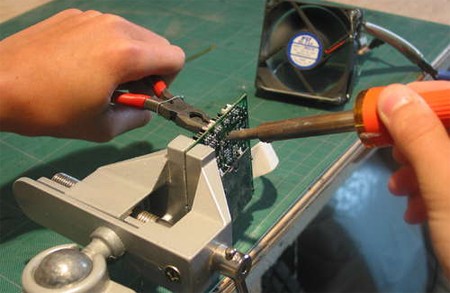
If you’re anything like us, you have a closet full of old electronics, some broken, some obsolete. You can stop using those as paperweights with the help of this guide that shows you how to recycle and reuse PCB components.
The first step of the process is finding electronics you don’t mind taking apart. Next place the PCB you’ll be stripping in a vice, with the components facing away from you and the solder side facing towards you. Grip the component you want with a pair of pliers, and apply a hot soldering iron to the solder that is holding the component. The solder will melt and allow you to safely and cleanly remove the component.
This process can be applied to virtually any component on an PCB, and the author of the guide, [Patented], got a lot of components this way, including resistors, capacitors, switches, audio jacks, and much more. Don’t forget to toss any free-floating metal or plastic parts in the recycle bin when you’re done. You can feel good about the fact that nothing was wasted, you found parts for your next project, and you cleared out some space.















I’ve been doing this since I was 8 years old… there are ALWAYS good parts on old boards. I hope someone doesn’t think this is a new idea, I was 8 over two decades ago…
That’s the ‘technique?’ To hold the thing and heat the hell out of it until the entire component is hot enough to pull free? How are you going to heat both sides of the component at once? Let the internal structure transfer the heat?
I love salvaging parts. I find it relaxing. Not much useful information in that instructable. A lot of the time you can gets parts off by just cutting the board with wire cutters right up to the leads of the components. That way you don’t risk cooking the parts.
*yawn* i can desolder stuff. wow.
useful hack but get yourself a desoldering iron…i got one for
What a waste. He is taking apart WORKING electronics for parts he probably won’t use. He didn’t know the difference between a ceramic cap and a resistor. Do you really think he will use them properly, if he even uses them at all?
Better than a de/soldering iron is a heat gun from harbor freight. $10. It cvers a larger area and works really well. Ive salvaged 1000s of parts with great success. It will burn the board but you probably dont need it anyway.
yawn…. how about some actual “hacks”
Or you could use a haot air gun for components that have more then 2 connections on the board. Makes life a whole lot easier
O_o I’ve also been doing doing this for years. You don’t want to know how many boxes of old PCBs i have lying around… I also tried the version with a heat gun once, but it only burned the board instead of making the components fall off. By the way: I never buy resistors or caps ^^
just last night i pulled 6 relays, lots of diodes, about 75 resistors, a sweet transformer, a bunch of big caps and some rca jacks/speaker connections out of an old JVC tuner that someone was going to throw away! i have already built a 15vdc power supply with the transformer, a few diodes, two caps and a lm7815. everything but the small cap came out of the tuner. plus i have a sweet shell to build my DIY synth into with recyclable buttons already mounted on the front.
Not useless, but the leads on these things are so short! How am I going to fit it in some breadboard?!
Without a real awareness of the internal structure of components, you are more likely to damage them than not using the guide. E.g. silicone transistors cannot have a junction temperature higher than about 200-210 degC for more than a few seconds, and if they are in small plastic packages it is very easy to reach that temperature with a normal 60 watt soldering iron in a few seconds. Small electrolytic caps are also very easily damaged by soldering heat, and you really should not salvage them if they are from a really old board, as they have a limited lifetime. Use solder wick (rather expensive) for very valuable DIP ceramic packages (though there is such variety in ICs you will probably never use them) to loosen all the pins first. do this one pin at a time to let the chip cool down. between pins. when all the solder is wicked up and the IC is cool, set your iron to about 400 degC and drag quickly across one side and life that side from the board. Let the chip cool down, and do the other side. DIP14, 16 and 18 chips can be harvested this way, but more pins will reduce your chance of success.
The main components I harvest are:
Power resistors (expensive),
optocouplers (most pins won’t be soldered and they come in DIP6 packages),
TO3 package Transistors (expensive, and normally easy to desolder to damage by heat), precision resistors,
varistors and PTCs (expensive),
and I always get out the ferrite cores/beads.
Transformers are another very useful part you can get out of older electronics (nowadays it’s mostly switching supplies that don’t yield good parts).
Always remove and keep heatsinks – they are invaluable.
most other parts are too easy to damage and not worth the trouble. I keep them on the boards, and only remove the parts if I am really stuck with a project.